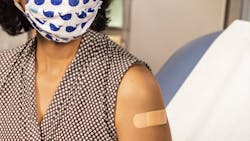Study concludes COVID-19 vaccines are safe after analysis of anaphylaxis cases
Following implementation of vaccination for COVID-19, cases of anaphylaxis after administration of the Pfizer-BioNTech and Moderna vaccines began to be reported, released JAMA Insights in a report of the reviewed cases. Anaphylaxis is a life-threatening allergic reaction that can occur after vaccination, with onset typically within minutes to hours.
The initial estimated reporting rates for anaphylaxis in the US were 11.1 cases per million doses administered of the Pfizer-BioNTech vaccine (December 14 to 23, 2020) and 2.5 cases per million doses administered of the Moderna vaccine (Dec. 21, 2020 to Jan. 10, 2021). Since these early estimates were generated, millions more doses of both vaccines have been administered and safety monitoring has detected additional cases of anaphylaxis. This analysis updates the reporting rates of anaphylaxis in individuals following receipt of either the Pfizer-BioNTech or Moderna vaccine.
The Vaccine Adverse Event Reporting System (VAERS), the national passive surveillance (spontaneous reporting) system for adverse events after immunization, captured notifications and reports of suspected anaphylaxis following vaccination. Physicians at the Centers for Disease Control and Prevention (CDC) evaluated these reports and applied the Brighton Collaboration case definition for anaphylaxis to classify cases.
During Dec. 14, 2020 through Jan. 18, 2021, a total of 9 943 247 doses of the Pfizer-BioNTech vaccine and 7,581,429 doses of the Moderna vaccine were reported administered in the US (CDC unpublished data, February 2021). CDC identified 66 case reports received by VAERS that met Brighton Collaboration case definition criteria for anaphylaxis (levels 1, 2 or 3): 47 following Pfizer-BioNTech vaccine, for a reporting rate of 4.7 cases/million doses administered, and 19 following Moderna vaccine, for a reporting rate of 2.5 cases/million doses administered. Cases occurred after receipt of doses from multiple vaccine lots.
CDC physician reviewers concluded that the clinical characteristics of anaphylaxis cases following both vaccines were similar. Furthermore, there were no apparent clinical differences between anaphylaxis cases with symptom onset within 30 minutes and those with symptom onset after 30 minutes (a 15-minute postvaccination observation period is recommended for all persons and a 30-minute period is recommended for those with a history of certain allergic reactions).
Common signs and symptoms in anaphylaxis cases were generalized urticaria, diffuse erythematous rash, angioedema, respiratory and airway obstruction symptoms, and nausea. Twenty-one (32 percent) of the 66 case reports noted a prior episode of anaphylaxis from other exposures; prior exposures included vaccines (rabies, influenza A[H1N1], seasonal influenza, unspecified), contrast media (gadolinium-based, iodine-based, unspecified intravenous), unspecified infusions, sulfa drugs, penicillin, prochlorperazine, latex, walnuts, unspecified tree nuts, jellyfish stings, and unspecified exposures.
In 61 (92 percent) of the anaphylaxis cases, patients received epinephrine as part of emergency treatment. All 66 persons were treated in health care settings; 34 (52 percent) were treated in an emergency department and 32 (48 percent) were hospitalized (including 18 in intensive care, seven of whom required endotracheal intubation). As determined by medical record review and follow-up with treating health care facilities and clinicians, of the seven patients who required endotracheal intubation, median time to symptom onset was 6 minutes (range, <1-45 minutes), with all but one patient having onset within 11 minutes. All seven of those intubated received epinephrine, six received corticosteroids, and five received antihistamines; facial, tongue, or laryngeal angioedema was present in four of these patients; and hospitalization ranged from one to three days. Sixty-one individuals (92 percent) with follow-up information available are known to have been discharged from care or had recovered at the time of report to VAERS. No deaths from anaphylaxis after vaccination with either product were reported.
Continued safety monitoring of mRNA COVID-19 vaccines in the US has confirmed that anaphylaxis following vaccination is a rare event, with rates of 4.7 cases/million Pfizer-BioNTech vaccine doses administered and 2.5 cases/million Moderna vaccine doses administered, based on information through Jan. 18, 2021. When considered in the context of morbidity and mortality from COVID-19, the benefits of vaccination far outweigh the risk of anaphylaxis, which is treatable. Because of the acute, life-threatening nature of anaphylaxis, immediate epinephrine administration is indicated for all cases. CDC guidance on use of mRNA COVID-19 vaccines and management of anaphylaxis is available. All facilities administering COVID-19 vaccines should have the necessary supplies and trained medical personnel available to manage anaphylaxis.
